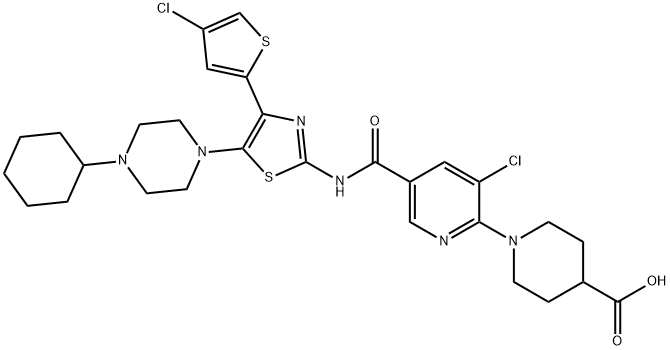CHEMICAL AND PHYSICAL PROPERTIES
| Solubility | Insoluble |
|---|
SAFETY INFORMATION
| Signal word | Danger |
|---|---|
| Pictogram(s) |
 Corrosion Corrosives GHS05 |
| GHS Hazard Statements |
H314:Skin corrosion/irritation |
| Precautionary Statement Codes |
P280:Wear protective gloves/protective clothing/eye protection/face protection. P310:Immediately call a POISON CENTER or doctor/physician. P305+P351+P338:IF IN EYES: Rinse cautiously with water for several minutes. Remove contact lenses, if present and easy to do. Continuerinsing. |
COMPUTED DESCRIPTORS
| Molecular Weight | 649.7 g/mol |
|---|---|
| XLogP3 | 4 |
| Hydrogen Bond Donor Count | 2 |
| Hydrogen Bond Acceptor Count | 10 |
| Rotatable Bond Count | 7 |
| Exact Mass | 648.1510867 g/mol |
| Monoisotopic Mass | 648.1510867 g/mol |
| Topological Polar Surface Area | 158 Ų |
| Heavy Atom Count | 42 |
| Formal Charge | 0 |
| Complexity | 935 |
| Isotope Atom Count | 0 |
| Defined Atom Stereocenter Count | 0 |
| Undefined Atom Stereocenter Count | 0 |
| Defined Bond Stereocenter Count | 0 |
| Undefined Bond Stereocenter Count | 0 |
| Covalently-Bonded Unit Count | 1 |
| Compound Is Canonicalized | Yes |
PRODUCT INTRODUCTION
description
Avatrombopag (Doptelet), is an orally administered, small-molecule thrombopoietin receptor (c-Mpl) agonist which increases platelet number, but not platelet activation,. This decreases the need for blood transfusions. Patients with thrombocytopenia and chronic liver disease (leading to thrombocytopenia) often require platelet transfusions before surgical procedures to decrease the risk of bleeding. Thrombocytopenia (or decreased numbers of platelets) is a common complication in patients suffering from chronic liver disease, either as an immediate result of liver disease or a consequence of interferon-based antiviral therapy. Avatrombopag was approved by the FDA on May 21, 2018 for thrombocytopenia (low platelets) in adults with chronic liver disease who are scheduled to undergo a procedure. It is administered orally as avatrombopag maleate, its salt form. Doptelet (Avatrombopag) is the first orally administered treatment option for patients with chronic liver disease, allowing a large population of patients to avoid a platelet transfusion before a procedure by increasing platelet counts to the optimal level of greater or equal to 50,000 per microliter.
